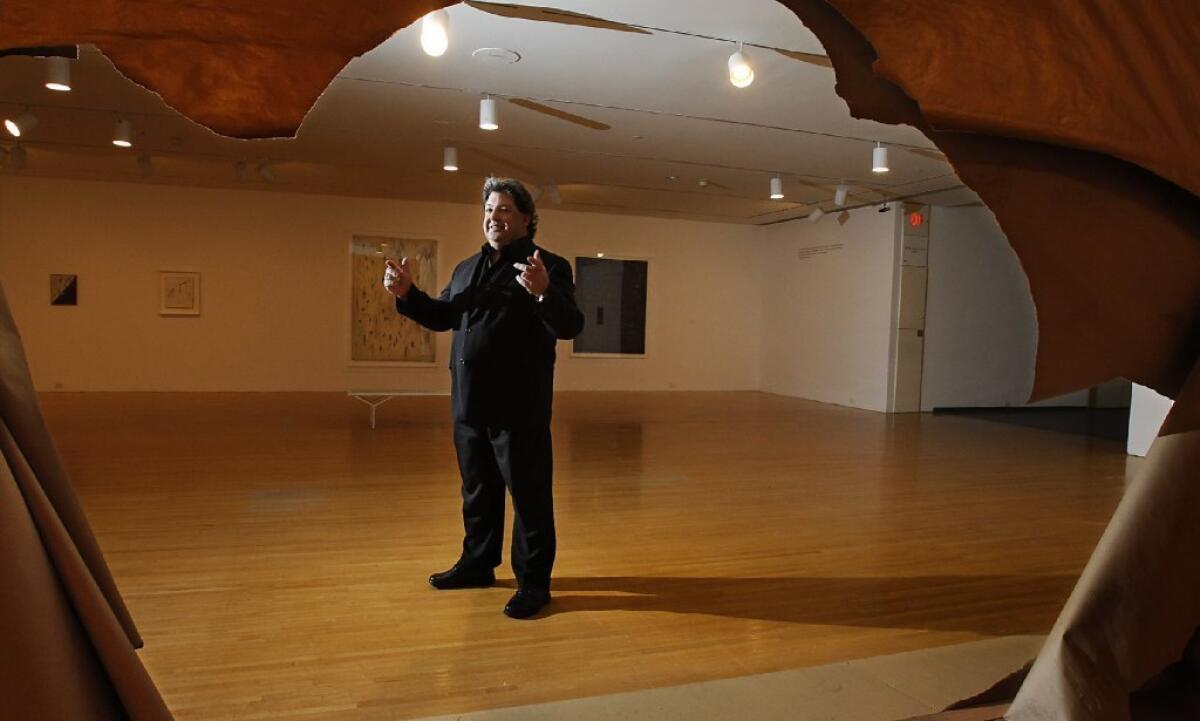Paul Schimmel joins gallery world, creating Hauser Wirth & Schimmel

- Share via
Former MOCA chief curator Paul Schimmel has signed on as a partner with the international gallery Hauser & Wirth. And yes, they are coming to Los Angeles.
Schimmel, 58, confirmed that he will be helping the powerhouse gallery, which currently has locations in Zurich, London and New York, to develop a new space in Los Angeles called Hauser Wirth & Schimmel. It is expected to open in 2015.
Do not, however, expect a West Coast gallery in the spirit of L&M Arts or Matthew Marks, which are smaller outposts of blue-chip New York operations.
“I think it’s going to be quite different in the respect that it will be done on a larger scale, have fewer exhibitions and a combination of selling and non-selling exhibitions,” said Schimmel, who served as MOCA’s chief curator from 1990 until his controversial resignation last summer and has never before worked in a commercial gallery setting.
He said he imagines three to five exhibitions a year that “come out of the Hauser & Wirth program but feel more museum-like in terms of scale, scholarship and complexity.” He also mentioned “museum-like amenities” such as an education program and public events.
He said a location for the gallery has not been lined up yet but that Hollywood and downtown are being looked at. “It more has to do with the right confluence of buildings to deal with different functions, and there is a real desire to convert an existing building rather than starting from scratch,” he said, describing a “ground-level warehouse space.”
FULL COVERAGE: 2013 Spring arts preview
“I would like it to be the easiest of all the Hauser & Wirth galleries to get art into and out of.”
The other partners in the business, which is known for long relationships with artists in an age of gallery-hopping, are Iwan Wirth, his wife Manuela Wirth, and Marc Payot, who oversees their New York operations. Schimmel said he has known Iwan Wirth (who was traveling and could not be reached for comment) since the early years of his gallery, founded in 1992.
That was the year when Schimmel’s “Helter Skelter” exhibition ran at MOCA, featuring over-the-top -- and sometimes gross-out -- installations by artists such as Paul McCarthy and Richard Jackson, both of whom went on to work with Hauser & Wirth. (Over the years Schimmel has also shown Hauser & Wirth artists Diana Thater, Jason Rhoades and Rachel Khedoori.)
Schimmel started out in the mid ‘70s as a young curator in Houston, and spent the next decade in California at the Newport Harbor Art Museum, the predecessor to the Orange County Museum of Art, before taking the MOCA job.
PHOTOS: Arts and culture in pictures by The Times
He soon made his name for championing important L.A. artists such as McCarthy, Chris Burden, Mike Kelley and Charles Ray and taking on big, sweeping themes in contemporary art.
His ambitious, generation-defining surveys for MOCA include the 1998 performance-art extravaganza “Out of Actions,” the 2005 altered-states show “Ecstasy” and the 2011 survey of the 1970s Californian art diaspora, “Under the Big Black Sun.”
In addition, Schimmel organized major traveling shows of artists Robert Rauschenberg, Willem de Kooning and Takashi Murakami.
L.A. Times art critic Christopher Knight has called Schimmel “a prime reason for the museum’s stellar international reputation. No curator working in the United States today has a more impressive record of exhibitions and acquisitions in the field of art since 1950 than Schimmel.”
CHEAT SHEET: Spring Arts Preview
His departure from MOCA last summer, widely seen as a sign of its leaders’ disregard for their own curatorial talent and history, triggered the exodus of four artist-trustees from the museum’s board.
Since that time, Schimmel has served as chairman of the Mike Kelley Foundation for the Arts, a charity that the late artist had set up in 2008 to help younger artists. But Schimmel recently gave up his nonprofit and foundation duties, including his advisory seat on the Committee for the Preservation of the White House and the Kelley Foundation post, because of his commitment to a commercial gallery.
“For me, the hardest thing about leaving the not-for-profit world is leaving the Mike Kelley Foundation. I think the world of what Mike did in terms of creating this substantial commitment to the next generation of artists, writers and musicians,” he said.
ALSO:
Filmmaker Stanley Kubrick redux at LACMA
LACMA executives moving to Variety building
Getty Museum buys ‘Rembrandt Laughing’: tiny portrait, huge value
More to Read
The biggest entertainment stories
Get our big stories about Hollywood, film, television, music, arts, culture and more right in your inbox as soon as they publish.
You may occasionally receive promotional content from the Los Angeles Times.










